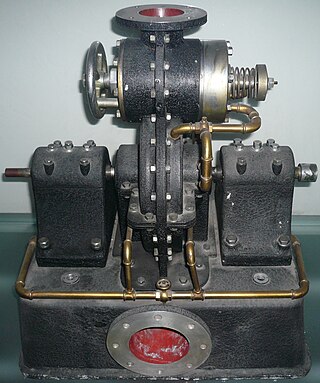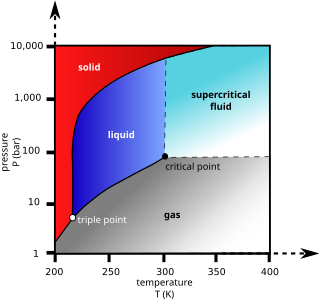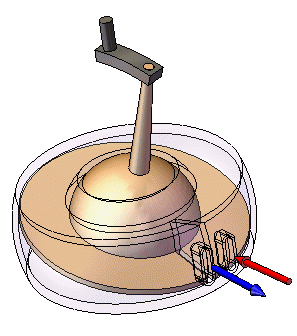
An engine or motor is a machine designed to convert one or more forms of energy into mechanical energy.

The Tesla turbine is a bladeless centripetal flow turbine patented by Nikola Tesla in 1913. It is referred to as a "bladeless turbine".

A compressed-air vehicle (CAV) is a transport mechanism fueled by tanks of pressurized atmospheric gas and propelled by the release and expansion of the gas within a pneumatic motor.

Turbomachinery, in mechanical engineering, describes machines that transfer energy between a rotor and a fluid, including both turbines and compressors. While a turbine transfers energy from a fluid to a rotor, a compressor transfers energy from a rotor to a fluid.

Supercritical carbon dioxide is a fluid state of carbon dioxide where it is held at or above its critical temperature and critical pressure.

A ventricular assist device (VAD) is an electromechanical device for assisting cardiac circulation, which is used either to partially or to completely replace the function of a failing heart. The function of a VAD differs from that of an artificial cardiac pacemaker in that a VAD pumps blood, whereas a pacemaker delivers electrical impulses to the heart muscle. Some VADs are for short-term use, typically for patients recovering from myocardial infarction (heart attack) and for patients recovering from cardiac surgery; some are for long-term use (months to years to perpetuity), typically for patients with advanced heart failure.

This Timeline of heat engine technology describes how heat engines have been known since antiquity but have been made into increasingly useful devices since the 17th century as a better understanding of the processes involved was gained. A heat engine is any system that converts heat to mechanical energy, which can then be used to do mechanical work.They continue to be developed today.
Tofy Mussivand is an Iranian-Canadian medical engineer of Kurdish origin who invented an Artificial Cardiac Pump, a device that pumps blood and takes over the function of breathing during a heart surgery.

A thermoelectric generator (TEG), also called a Seebeck generator, is a solid state device that converts heat flux directly into electrical energy through a phenomenon called the Seebeck effect. Thermoelectric generators function like heat engines, but are less bulky and have no moving parts. However, TEGs are typically more expensive and less efficient.

An automotive thermoelectric generator (ATEG) is a device that converts some of the waste heat of an internal combustion engine (IC) into electricity using the Seebeck Effect. A typical ATEG consists of four main elements: A hot-side heat exchanger, a cold-side heat exchanger, thermoelectric materials, and a compression assembly system. ATEGs can convert waste heat from an engine's coolant or exhaust into electricity. By reclaiming this otherwise lost energy, ATEGs decrease fuel consumed by the electric generator load on the engine. However, the cost of the unit and the extra fuel consumed due to its weight must be also considered.

A nutating disc engine is an internal combustion engine comprising fundamentally of one moving part and a direct drive onto the crankshaft. Initially patented in 1993, it differs from earlier internal combustion engines in a number of ways and uses a circular rocking or wobbling nutating motion, drawing heavily from similar steam-powered engines developed in the 19th century, and similar to the motion of the non-rotating portion of a swash plate on a swash plate engine.

Micropumps are devices that can control and manipulate small fluid volumes. Although any kind of small pump is often referred to as micropump, a more accurate definition restricts this term to pumps with functional dimensions in the micrometer range. Such pumps are of special interest in microfluidic research, and have become available for industrial product integration in recent years. Their miniaturized overall size, potential cost and improved dosing accuracy compared to existing miniature pumps fuel the growing interest for this innovative kind of pump.
Impella is a family of medical devices used for temporary ventricular support in patients with depressed heart function. Some versions of the device can provide left heart support during other forms of mechanical circulatory support including ECMO and Centrimag.
Erythrocyte fragility refers to the propensity of erythrocytes to hemolyse (rupture) under stress. It can be thought of as the degree or proportion of hemolysis that occurs when a sample of red blood cells are subjected to stress. Depending on the application as well as the kind of fragility involved, the amount of stress applied and/or the significance of the resultant hemolysis may vary.
Phillip Meredith Ligrani is an American mechanical engineer. As of 2022, he is eminent scholar in propulsion and professor of mechanical and aerospace engineering at the University of Alabama in Huntsville.
Pump thrombosis (PT) is considered a specific case of a major device malfunction, and is classified as either suspected or confirmed pump thrombus. Typically, the device is an implanted blood pump such as a Left ventricular assist device. The malfunction is a blockage in the flow of blood anywhere along a vessel (upstream or downstream) and it is mainly due to the bio-incompatible presence of a fairly complex mechanical apparatus. Pump thrombus is dreaded complication of CF LVAD technology that can require repeat surgery to replace the pump or lead to death.
Avinash Kumar Agarwal is an Indian mechanical engineer, tribologist and a professor at the Department of Mechanical Engineering of the Indian Institute of Technology, Kanpur. He is known for his studies on internal combustion engines, Emissions, alternate fuels and CNG engines and is an elected fellow of the American Society of Mechanical Engineering (2013), Society of Automotive Engineers, US (2012), National Academy of Science, Allahabad (2018), Royal Society of Chemistry, UK (2018), International Society for Energy, Environment and Sustainability (2016), and Indian National Academy of Engineering (2015). The Council of Scientific and Industrial Research, the apex agency of the Government of India for scientific research, awarded him the Shanti Swarup Bhatnagar Prize for Science and Technology, one of the highest Indian science awards for his contributions to Engineering Sciences in 2016. Agarwal has been bestowed upon Prestigious J C Bose Fellowship of Science and Engineering Research Board. Government of India. Agarwal is among the top ten highly cited researchers (HCR) of 2018 from India, as per Clarivate Analytics, an arm of Web of Science.
Glenn Barton Warren was an American mechanical engineer, business executive and inventor, who was vice president and general manager of the turbine division of General Electric. In 1951 he was awarded the ASME Medal.

Ashwani K. Gupta is a British-American engineer and educator with research focus on combustion, fuels, fuel reforming, advanced diagnostics, High Temperature Air Combustion, and high-intensity distributed combustion, green combustion turbine, micro-combustion, and air pollution. He is an Distinguished University Professor at the University of Maryland. Gupta is also Professor of Mechanical Engineering at the University of Maryland and Director of Combustion Laboratory. He is also an Affiliate Professor at Institute of Physical Science and Technology, University of Maryland which is part of the University of Maryland College of Computer, Mathematical and Natural Sciences.
Zoltán S. Spakovszky is an aerospace engineer, academic and researcher. He is best known for his work on fluid system instabilities and internal flow in turbomachinery. He is a Professor of Aeronautics and Astronautics at the Massachusetts Institute of Technology, and the Director of the MIT Gas Turbine Laboratory.











